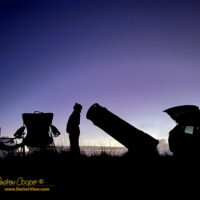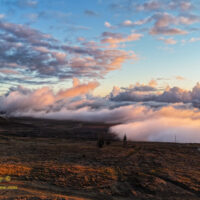While I have gotten plenty of telescope time lately, it has usually been morning sessions with the old Astrola in my driveway. This is a low effort and thoroughly enjoyable practice that I engage in about half a dozen times each month. Such sessions do mean that my 18″ telescope languishes for far too long in the garage.
I really need to change that.
Thus when my fellow staff at Symbrosia start asking for another star party it made a good excuse to get the big ‘scope out of the garage and under a dark sky.
I arrived to a landscape draped in fog. A low cloud hung across the mountainside and a higher layer of cumulus clouds swept out of the south. Undeterred I began to setup the ‘scope. I have been here so many times before and from experience expected the clouds to depart at sunset.
And depart they did, breaking up and dissipating as the Sun set on the far western horizon. The low ground fog retreated down the side of the mauna as the Sun’s heat waned, sinking down as if a wave flowing back from the beach. Shortly after sunset we had nothing but clear sky overhead promising a good night of observing.
When the others arrived they found me standing beside the big ‘scope and joined me in awaiting darkness. We chatted and snacked on the chips and popcorn, we watched the first stars appear in the blue sky, we simply enjoyed a beautiful evening on the mauna.
Omega Centauri was our first target, in one of the first regions of sky to grow dark it showcased the capabilities of a big dobsonian, the awe inspiring sight of a million stars in a tight globular cluster, nothing better to begin with.
There was much to see… Open star clusters, globular clusters, bright nebulae and dark nebulae, and galaxies with the spiral arms quite visible. M6, M51, M104, M57, M8, NGC 5139, B86 & NGC 6520, M17, and M11, we viewed a little bit of everything, the sky offering much to enjoy and think about.
The mist returned around 9pm. I noted bright streaks in the laser beam as I pointed out features in the rising Milky Way. Not too bad, we could still enjoy the view despite the thin fog overhead. The mist arrived with dew that quickly coated exposed equipment.
We spent as much time just talking, asking questions, and chatting about all things astronomy. My green laser stabbed the sky as I explained the structure of the Milky Way galaxy, pointed out clusters and particular stars. We talked about telescopes, lightyears, and looking back in time. A dark sky reveals so much about our universe and the nature of existence.
A cool and dry breeze flowing downslope from the mauna eventually pushed the mist and dew away and again we had a clear sky to enjoy.
It was near 2230 when my audience left and I had a dark sky to myself. So I set about tackling my observing list for the evening. I had a couple hours before moonrise to use.
- NGC 6397 – Big! Bright! a spectacular globular cluster in the large telescope, 20′ in diameter, a coarse appearance compared to the usual globular cluster mist of faint stars, here I see brighter stars punctuating a relatively sparse population of fainter stars, a moderately concentrated core about 5′ in diameter, fully resolved in rich galactic starfield
- V539 Arae – White, a 9th magnitude companion easily visible 12″ west in rich galactic starfield
I linked the iPad and SkySfari to the telescope so I could use the live star chart to hunt object in my observing list along the southern horizon. I had not done this with Violet before and was plesantly surprised at how well it worked. So often computer and telescope automation is a feature with too many frills and gimmiks that are not all that useful. The setup I was using here is a simple circle on the chart indicating where the ‘scope is pointing. A clean solution that just does the job.
So I hopped around the sky enjoying a few objects I had been to before, and a few I had never observed.
- IC 4642 – Small, faint, a round nebula in rich galactic starfield, about 20″ across, central star visible, no color or other structure noted
- HR 6908 Pale orange, a 12th magnitude 1″ companiopn is not visible in the poor seeing at low elevation
- NGC 6553 A dense globular, round 7′ in diameter, gradually brighter to the center without a notable core, partially resolved in rich galactic starfield
It was the mist that shut me down in the end as I noted difficulty in seeing 12th magntude galaxies, something that should have been easy in the large ‘scope. This time the mist was little higher altitude, a creeping haze that veiled the stars, dimming the view in the telescope and slowly covering the whole sky despite my attempts to keep ahead of it.
With misty stars in the eyepiece and moonrise occuring soon I elected to pack up the telescope and head for home.




